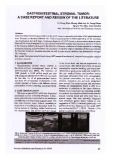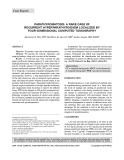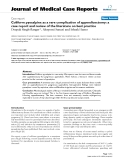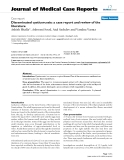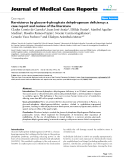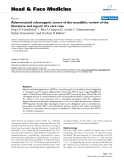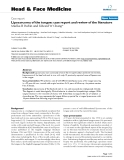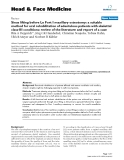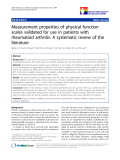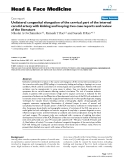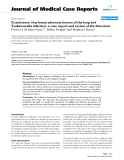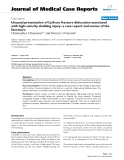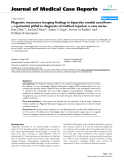Case Report
PARATHYROMATOSIS: A RARE CASE OF RECURRENT HYPERPARATHYROIDISM LOCALIZED BY FOUR-DIMENSIONAL COMPUTED TOMOGRAPHY
Abraham E. Wei, DO1; Matthew R. Garrett, MD2; Ankur Gupta, MD, FACE1
ABSTRACT
Conclusion: This case report represents the first-time use of 4DCT to localize parathyromatosis. Parathyromatosis is a rare but problematic cause of recurrent hyperparathy- roidism. Ultrasound and 4DCT may represent the best imaging modalities for identification and perioperative management to remove all affected tissue without reseed- ing. (AACE Clinical Case Rep. 2019;5:e384-e387)
Abbreviations: CT = computed tomography; 4DCT = four-dimension- al computed tomography; PTH = parathyroid hormone
INTRODUCTION
Objective: To present a rare case of parathyromatosis. Methods: We present the clinical, laboratory, and imaging findings, along with a review of the literature. Results: A 33-year-old man with a history of right upper parathyroid adenoma removal 5 years prior due to hyperparathyroidism was admitted for severe hypercalce- mia (15.6 mg/dL; normal, 8.5 to 10.5 mg/dL) with elevated plasma parathyroid hormone (PTH) (882 pg/mL; normal, 15 to 65 pg/mL). Ultrasound, computed tomography (CT), sestamibi, and positron emission tomography scans were unremarkable; however, a four-dimensional CT (4DCT) of the neck showed an area of increased signal enhance- ment and hypervascularity without discrete nodule in the posterior right thyroid region. The patient underwent para- thyroid surgical exploration with right hemithyroidectomy and compartment neck dissection to remove the affected tissue. PTH levels dropped to 208 pg/mL postoperatively; calcium decreased but remained elevated at 12.7 mg/dL. Pathology revealed the presence of several small nodular foci of atypical hyperplastic parathyroid tissue in the right thyroid and soft tissue in the left central neck compartment consistent with parathyromatosis.
Parathyromatosis is a rare condition of multiple nests of hyperfunctioning parathyroid tissue. It is likely either the result of spillage and seeding of parathyroid tissue around an operative area during parathyroid surgery or the change in embryologic foci of parathyroid tissue that become hyperplastic with physiologic stimuli (1). Preoperative diagnosis and subsequent treatment can be difficult. Imaging is important for identification and peri- operative management to remove all affected tissue with- out reseeding. This case report describes the diagnostic challenges for this condition as well as the first-time use of four-dimensional computed tomography (4DCT) in the diagnosis of parathyromatosis.
CASE REPORT
Submitted for publication May 14, 2019 Accepted for publication August 8, 2019 From 1Wright State University Boonshoft School of Medicine, Dayton, Ohio, and 2Southwest Ohio Ear, Nose, and Throat Specialists, Dayton, Ohio. Address correspondence to Dr. Abraham Wei, Wright State University Internal Medicine Residency, 1 Wyoming Street, Dayton, OH 45419. E-mail: Abraham.wei@wright.edu. DOI: 10.4158/ACCR-2019-0225 To purchase reprints of this article, please visit: www.aace.com/reprints. Copyright © 2019 AACE.
A 33-year-old man first presented at 28 years of age with epigastric pain and was found to have serum calcium of 18.1 mg/dL (normal, 8.5 to 10.5 mg/dL) and an elevated plasma parathyroid hormone (PTH) level of 1,199 pg/mL (normal, 14 to 72 pg/mL). Computed tomography (CT) of the neck revealed a 2 cm nodule posterior to the superior
e384 AACE CLINICAL CASE REPORTS Vol 5 No. 6 November/December 2019
showed the presence of abnormal parathyroid tissue inti- mately involved with the right thyroid lobe. Intraoperative biopsies of right inferior, left superior, and left inferior parathyroid appeared normal and were not hyperplas- tic. Central compartment neck dissection was completed without additional abnormal parathyroid tissue identified. Postoperatively, calcium level decreased but remained elevated at 12.7 mg/dL. Cinacalcet, which had been held before surgery, was restarted. Three days after surgery, serum calcium improved and stabilized at 9.9 mg/dL and PTH improved to 174 pg/mL. The patient was subsequent- ly discharged. Pathology showed the presence of several small nodular foci of atypical hyperplastic parathyroid tissue without invasive growth in the right thyroid and soft tissue in the left central neck compartment consistent with parathyromatosis.
Parathyromatosis and Imaging, AACE Clinical Case Rep. 2019;5(No. 6) e385
DISCUSSION
right lobe of the thyroid gland and the patient underwent a right upper parathyroidectomy. Repeat labs 2 weeks later showed normalization of calcium at 9.2 mg/dL and of PTH at 64 pg/mL (Table 1). Pathology was consistent with an atypical parathyroid adenoma described as neoplastic para- thyroid cells in trabecular arrangement with interspersing fibrovascular bands without mitosis nor evidence of vascu- lar or perineural invasion. Five years later, the patient developed abdominal pain, nausea, and vomiting for 9 days and was admitted for an elevated serum calcium of 15.6 mg/dL (normal, 8.5 to 10.5 mg/dL) with an elevated PTH level of 882 pg/mL (normal, 15 to 65 pg/mL). Physical exam was only significant for mild epigastric tenderness on deep palpation. Serum creatinine was also noted to be elevated at 1.6 mg/dL (normal, 0.5 to 1.4 mg/dL) attributed to poor fluid intake by the patient. Urinary calcium was noted to be high at 530 mg/24 hours (normal, 50 to 150 mg/24 hours) and serum 25-hydroxyvitamin D was low at 21 ng/mL (normal, >30 ng/mL). Intravenous normal saline given during the hospital stay improved serum creatinine to baseline level of 1.0 mg/dL. Serum calcium continued to remain high and greater than 14 mg/dL. Cinacalcet 30 mg twice-a-day was then initiated. Ultrasound of the neck, technetium-sestamibi scan with single photon emission CT, CT soft tissue neck with contrast (Fig. 1 A) were all unremarkable. CT chest/abdo- men/pelvis with contrast and positron emission tomog- raphy (PET) scan did not show any evidence of ectopic tumors or distant metastasis. A 4DCT of the neck was then obtained that showed an area of increased signal enhance- ment and hypervascularity without a discrete nodule in the posterior right thyroid region near the site of prior parathy- roid adenoma removal (Fig. 1 C). The patient then under- went parathyroid surgical exploration with right hemithy- roidectomy, and intraoperative frozen section analysis
Parathyromatosis is a rare cause of recurrent hyper- parathyroidism consisting of multiple nodules of benign hyperplastic and hyperfunctioning parathyroid tissue after spillage and seeding of parathyroid tissue during parathy- roid surgery. Another cause of parathyromatosis describes embryonic rests of parathyroid tissue that undergo hyper- plasia under the influence of physiological stimuli such as end-stage renal disease. Our patient’s past operative report on his parathyroid adenoma removal makes no mention of spillage of parathyroid tissue, but this can still be a possible cause of his parathyromatosis. Otherwise, this may be some form of disorder which allows local cells to differentiate into parathyroid cells. Epidemiologic data reveal parathy- romatosis affects people across a wide age range from 19 to 87 years old with the majority being female or having end-stage renal disease, which makes our patient different
Table 1 Patient Laboratory Values
Event Calcium (mg/dL, normal 8.5-10.5 mg/dL) PTH (pg/mL, normal 14-72 pg/mL) 18.1 1,199 On admission prior to surgery 1 day after surgery 9.0 NR First presentation (parathyroid adenoma with parathyroidectomy) 2 days after surgery (discharge day) 8.8 NR 2 weeks after surgery 9.2 64
Event Calcium (mg/dL, normal 8.5-10.5 mg/dL) PTH (pg/mL, normal 15-65 pg/mL) 15.6 882 12.7 On admission prior to surgery 1 day after surgerya NR Second presentation 5 years after first presentation (parathyromatosis with hemithyroidectomy) 2 days after surgery 10.0 NR 174 3 days after surgery (discharge day) 9.9
Abbreviations: NR = not reported; PTH = parathyroid hormone. Values in bold are out of normal range. aStarted oral cinacalcet 30 mg twice a day.
e386 Parathyromatosis and Imaging, AACE Clinical Case Rep. 2019;5(No. 6)
A
B
C
D
Fig. 1. A, Regular CT with contrast. B, 4DCT without contrast. C, 4DCT arterial phase with contrast enhance- ment in right posterior thyroid (red arrow) where previous parathyroid adenoma was located and resected. D, 4DCT 90-second delay (venous) phase. CT = computed tomography; 4DCT = four-dimensional computed tomography.
from most cases (2,3,4). Parathyromatosis is often refrac- tory to surgical intervention due to incomplete removal and reseeding of hyperplastic parathyroid tissue (2). Mortality from complications of parathyromatosis can be high with one case series reporting a mortality rate of 40% (5). Successful imaging of these small nodules of hyper- plastic parathyroid tissue and obtaining a preoperative diagnosis is difficult, but it enhances the chances of surgi- cally removing all involved tissue. In a case series of 10 patients, only 40% of patients were successfully diagnosed with parathyromatosis preoperatively (3). Ultrasound can sometimes detect scattered hypoechoic, vascular small nodules in thyroid tissue suggesting the diagnosis (6). CT, sestamibi, and PET scans can reveal findings of parathyro- matosis but are often negative (2). In our patient, all these modalities failed to localize parathyromatosis. We then obtained a 4DCT to localize the affected tissue and optimize perioperative management and surgical resection. 4DCT may be a popular imaging option to local- ize and diagnose parathyromatosis in the future. 4DCT is a relatively new imaging modality first introduced in 2006 that is utilized in the diagnosis and characterization of suspected parathyroid adenoma as well as for brain aneu- rysms, arterial-venous malformations, musculoskeletal conditions such as joint instability, and internal impinge- ment (7). Intravenous contrast is given and CT scans are obtained at specific time-points corresponding to venous and arterial circulations which enhances the quality of the images. In a study of 45 patients who previously under- went parathyroidectomy, sensitivity for localization of hyperfunctioning parathyroid tissue for reoperation was 88% for 4DCT compared to 54% for sestamibi imaging
(8). The enhanced capability to image abnormal hypervas- cular tissues with 4DCT makes it a good diagnostic test of choice for localizing parathyromatosis. Pathology of parathyromatosis often reveals multi- ple nests of hyperplastic parathyroid cells with a lack of real capsule of the parathyroid tissue and without lymph- vascular invasion that is seen in an adenoma or cancer (9). Definitive treatment is surgical removal of all offending tissue; however, it is difficult to identify and remove all the disseminated tiny nodules of hyperplastic parathy- roid tissue that often adhere closely to scar tissue thereby hindering excision. Even the more aggressive measure of total thyroidectomy does not ensure cure as parathyromato- sis tissue can remain in surrounding muscular or fat tissue (3). Many cases are often refractory to or incompletely cured with surgery, such as in our case where postoperative PTH and serum calcium levels remained elevated, indicat- ing incomplete removal of all affected parathyromatosis tissue. Without localization via 4DCT, less parathyroma- tosis tissue would have been removed or more tissue seed- ing might have occurred if blind surgical manipulation was done, likely leading to worse outcomes. After failed surgical intervention, suppression of PTH production with the calcium mimetic cinacalcet is the phar- macologic treatment of choice. Bisphosphonates may also be added to both decrease calcium levels and to minimize the deleterious effect of PTH on the bone, especially if there is concern for concomitant osteopenia or osteoporosis (2). Several cases also successfully used vitamin D analogs (e.g., paricalcitrol, doxercalciferol) to further inhibit PTH synthesis and parathyromatosis activity, although at a cost of increasing serum calcium level (6,10). Even with phar-
2. Hage MP, Salti I, El-Hajj Fuleihan G. Parathyromatosis: a rare yet problematic etiology of recurrent and persistent hyperparathy- roidism. Metabolism. 2012; 61;762-775.
macologic interventions, parathyromatosis activity may not be controlled. Ideally, this condition should be prevent- ed in the first place by avoiding rupture of the parathyroid capsule during parathyroidectomy.
3. Matsuoka S, Tominaga Y, Sato T, et al. Recurrent renal hyper- parathyroidism caused by parathyromatosis. World J Surg. 2007;31:299-305.
Parathyromatosis and Imaging, AACE Clinical Case Rep. 2019;5(No. 6) e387
CONCLUSION
4. Fernandez-Ranvier GG, Khanafshar E, Jensen K, et al. Parathyroid carcinoma, atypical parathyroid adenoma, or parathy- romatosis? Cancer. 2007;110:255-264.
5. Stehman-Breen C, Muirhead N, Thorning D, Sherrard D. Secondary hyperparathyroidism complicated by parathyromatosis. Am J Kidney Dis. 1996;28:502-507.
6. Tublin ME, Yim JH, Carty SE. Recurrent hyperparathyroid- ism secondary to parathyromatosis: clinical and imaging findings. J Ultrasound Med. 2007;26:847-851.
This case represents the first reported use of 4DCT to localize parathyromatosis tissue. 4DCT is very sensitive in detecting hypervascular hyperparathyroid tissue. This may become a popular imaging modality to localize and diag- nose parathyromatosis. However, parathyromatosis may be refractory to surgical and pharmacologic interventions in several cases.
DISCLOSURE
7. Kwong Y, Mel AO, Wheeler G, Troupis JM. Four-dimensional computed tomography (4DCT): a review of the current status and applications. J Med Imaging Radiat Oncol. 2015;59:545-554. 8. Mortenson MM, Evans DB, Lee JE, et al. Parathyroid explo- ration in the reoperative neck: improved preoperative localiza- tion with 4D-computed tomography. J Am Coll Surg. 2008;206: 880-895.
The authors have no multiplicity of interest to disclose.
9. Aksoy-Altinboga A, Akder Sari A, Rezanko T, Haciyanli M, Orgen Calli A. Parathyromatosis: critical diagnosis regarding surgery and pathologic evaluation. Korean J Pathol. 2012;46: 197-200.
10. Daphnis E, Stylianou K, Katsipi I, et al. Parathyromatosis and
REFERENCES
the challenge of treatment. Am J Kidney Dis. 2006;48:502-505.
1. Reddick RL, Costa JC, Marx SJ. Parathyroid hyperplasia and
parathyromatosis. Lancet. 1977;1:549.

